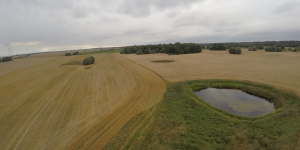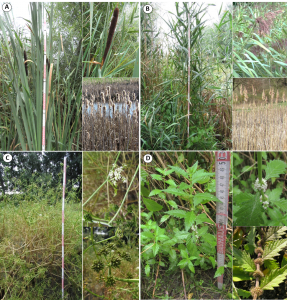**This post is a part of the series on the 2019 AGA Presidential Symposium – Sex and Asex: the genetics of complex life cycles**
 About the author: Sissi is an evolutionary ecologist interested in how plants reproduce and interact with their biotic environment, in particular with their pollinators. She is a postdoctoral fellow currently working on the genetics basis of flower size on Royal irises in Sapir Lab at Tel Aviv University, Israel. Her current project involves transcriptomics, floral traits and pollination observations. After finishing her bachelor studies in Bolivia, Sissi moved to Germany where she received her MS in Plant Sciences at University of Bonn and later her PhD in Botany and Evolutionary Biology at Potsdam University. During her master she focused on pollination and breeding systems and for her PhD she investigated gene flow and connectivity of wetland plant communities. More details about her current and past projects can be found at www.slozadagobilard.comand also on Twitter @SLozadaGobilard.
About the author: Sissi is an evolutionary ecologist interested in how plants reproduce and interact with their biotic environment, in particular with their pollinators. She is a postdoctoral fellow currently working on the genetics basis of flower size on Royal irises in Sapir Lab at Tel Aviv University, Israel. Her current project involves transcriptomics, floral traits and pollination observations. After finishing her bachelor studies in Bolivia, Sissi moved to Germany where she received her MS in Plant Sciences at University of Bonn and later her PhD in Botany and Evolutionary Biology at Potsdam University. During her master she focused on pollination and breeding systems and for her PhD she investigated gene flow and connectivity of wetland plant communities. More details about her current and past projects can be found at www.slozadagobilard.comand also on Twitter @SLozadaGobilard.
The topic for the blog is “Behind the scenes,” but I was a bit concerned because I had no idea what to write about. At least if it were the summary of the paper, I would know how to start. As I thought about it, there were hidden things that happened in the making of this study.
First a bit of context. When I started my PhD at the University of Potsdam (Germany), I was a student in the BioMove Graduate School (www.biomove.org) together with other 11 motivated students. The main goal of the BioMove project is to study how movement affects diversity from different perspectives and using different study organisms. I was the plant part of the group. As you can imagine, linking diversity with movement in plants is not very straightforward, at least not as much as for mobile animals.
Plants do not move. They cannot search for a better place to live or search for a mate. Instead, they disperse certain parts (pollen, fruits and seeds) using different vectors like wind, water or animals. The two most important processes determining the life of the next generation of plants are pollination and seed dispersal. So they mainly move when they reproduce, although sometimes roots or stems can also be transported by animals accidentally. Actively tracking this movement is impossible. Imagine tracking thousands or millions of pollen grains or seeds…a never ending story.
Due to this limitation, other methods, like using genetic markers are a good option. The idea of my project was to link genetic diversity and gene movement in certain species occurring in small water bodies called kettle holes. These kettle holes are small ponds distributed in agricultural landscapes (Figure 1). Our study site was located north of Berlin with a high density of these ponds (40 per km2). These ponds have been monitored by the Leibniz Centre for Agricultural Landscape Research (ZALF) for the last decade.

My first task was to select which species to study. I went to check the database of ZALF to find which species might be interesting to compare. My priority was abundance over the years. I came up with a final list of approx. 10 species and after some discussion with my supervisors, I decided to focus on 2 of them: Oenanthe aquatica andLycopus europaeus. The plan was to develop microsatellites to study the genetic patterns of these two species.
But then, after 1 or 2 weeks, a paper came out focusing on genetic connectivity of exactly those two species along ditches in France (Favre-Bac et al 2016). I was shocked! I couldn’t believe it. I was upset and disappointed. I didn’t know what to do. I had to change my study, but how? Changing or adding more species? After a lot of thinking, I decided to keep those two species (to use the developed markers of the recent published study) and add 2 new ones. What had seemed to be a disaster in the beginning, turned out to be of great help.
I searched for other two abundant species also based on the availability of microsatellites and their dispersal strategies. With four species there was less time to develop new markers. So I decided to pick Typha latifolia and Phragmites australis. Very abundant species in the ponds and with molecular markers readily available (Figure 2). Most of the markers developed by the recent published paper, worked perfectly with my samples, but I had some difficulties with the other markers of Typha and Phragmites. After a lot of trial and error, we finally found some that worked.

Since I started my PhD around three months later than my colleagues, I had to plan my first year very quickly. Suddenly, the field season was upon me. I selected the two extra species very fast without considering other aspects, like asexuality. It was at Conservation Genetics workshop part of ReGeneC (www.regenec.org) where, with the help of the people there, I realized that the degree of clonality in these species was very important and was going to affect the genetic patterns.
And that is how I changed my story, adding clonality as an important parameter. Because of this, I later got a chance to give a talk in the AGA Symposium Sex and Asex. And after the Symposium there was a chance to publish a Special Issue where my paper, after three major revisions and almost a year of hard work, was finally accepted.
In this study, every part led to the next. There were many challenges in between but at the end it is a contribution to science, and that is what matters. I learned a lot on the way, not only about my system and species but also being able to adapt and finding creative solutions to overcome challenges.
I want to express my gratitude to the editor Maria Orive and the two anonymous reviewers, whose comments and revisions helped improve the final version of our paper: “Genetic diversity and connectivity in plant species differing in clonality and dispersal mechanisms in wetland habitats”, and to the AGA team, specifically Stacy Krueger-Hadfield and Anjanette Baker, for giving me the opportunity to share the hidden story of my science behind the scenes. Thank you all!



